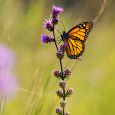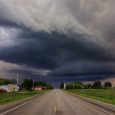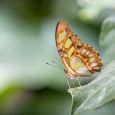The Gift of South Dakota
Subscriptions to South Dakota Magazine make great gifts!
Subscribe today — 1 year (6 issues) is just $29!
Butterfly Week
 |
| A mustard white at the Waubay National Wildlife Refuge in Day County. |
Every year, a colorful bonanza appears on the prairies of northeastern South Dakota. I call it the “Biggest Week of Butterflies.”
From the last few days of June through July 4, some of the state’s most colorful and shortest-lived residents emerge to mate, lay eggs and impress those who are in the field watching. One of these is the diminutive Dakota skipper (Hesperia dacotae), a prairie butterfly listed in 2014 as threatened under the Endangered Species Act. It appears for its only “flight” of the year, frequently perching on coneflowers awaiting a mate or a lucky photographer.
I didn’t think much about butterflies in my youth. I got into this hobby as a bored bird watcher looking for something to amuse myself. I chase rare bird reports all over the country and have seen every breeding bird in North America. It took 300,000 miles, but in 2016 I saw them all in a single year, plus many other rarities.
Bird watching can get slow in the dog days of summer. A few years ago, I bought a new camera lens in July and needed something to film. An orange butterfly caught my attention. I posted the picture on Facebook and instantly people wanted to know where I had seen it.
Once you’ve seen a few interesting insects, a guy like me gets hooked, buys a field guide and wonders what else is out there. I was instantly drawn to the rarer species, since few decent photographs of Dakota skippers existed online (and a few were not even of the correct species). I made a goal to get better photos of them.
The locations of the skippers appear to be a closely guarded secret. These little butterflies can be difficult to find or even see, unless you know where, when and how to look for them. I have found skippers through dumb luck, persistence, researching federal filings, and once, while I was lost. On that occasion, I stumbled upon a Roberts County ranch for sale at auction. I walked around the property, which led me to bid on the land, and the next thing I knew I was a landowner. Later, while again ambling aimlessly around my new prairie, I stumbled upon my first Dakota skippers.
Despite the challenges, my bucket list item of seeing the Dakota skipper has been rewarding. Some of the undisturbed fields on the Coteau des Prairies in northeast South Dakota’s lake country hold the last refuges for this insect devastated by pesticide and the slow and steady loss of virgin prairies. Whether or not you successfully find this butterfly, roaming the prairie in early summer is a grand adventure. At least I have saved my parcel from further damage.
 |
| A rare Dakota Skipper found in the Enemy Swim Lake watershed. |
These small orangish butterflies live simple lives. Dakota skippers have four basic life stages: egg, larva, pupa and adult. During the brief adult period in June and July, females lay up to 250 eggs, one at a time, on the underside of leaves, if enough nectar and moisture is present. Eggs take about 10 days to hatch into small caterpillars. After hatching, larvae build shelters at or below the ground surface and emerge at night to feed on little and big bluestem leaves. This continues until fall when the caterpillars become dormant. They overwinter in shelters at or just below ground level, usually in the base of native little bluestem bunches. The following spring, larvae emerge to continue developing. Pupation takes about 10 days. The males emerge first, about four to five days before the females. Their lives are at most three weeks but usually less and right in the heat of the summer.
There are other butterflies to see besides the Dakota skipper. Another much more impressive resident of these same areas is the regal fritillary (Speyeria idalia), a large, colorful butterfly that was once widespread over the eastern half of the United States. It is now also one of the nation’s many vanishing species of butterflies as its eastern range has now retracted into small, isolated populations and into an area of the historic tallgrass prairies and plains from Kansas to North Dakota. The area around Summit, northeast of Watertown, seems to have more of these colorful butterflies than most. Starting around the last week of June many can also be seen lazily flying over the grasslands for a few weeks.
There has been much concern about this species’ future with a loss of more than 99 percent of the original native tallgrass prairie land cover, decreased sustainable habitat and a generalized loss of its caterpillar foodplant — violets. Although this butterfly is not listed as threatened or endangered, there is much speculation that it will be listed soon.
Not all skippers are Dakota skippers. Most are a different species (South Dakota is home to dozens of skipper species), and many are difficult to identify. The state is also home to at least eight commonly encountered orange colored fritillary species that range from large ones like the regal and the great spangled fritillary (Speyeria cybele) to ones about a third the size, like the meadow fritillary. Luckily, only the regal fritillary seems to be in immediate peril. Not all butterflies emerge in mid-summer. Some come out in early May and others wait until late summer. Sometimes, when you see them is almost as important as what you see them feeding or displaying on.
One butterfly species has already disappeared in the Upper Midwest. The Poweshiek skipperling has not been seen in South Dakota since 2008 when a few were spotted in Day and Deuel counties. People like me hope they are quietly living in some hidden spot. Sadly, I have never seen this diminutive butterfly that now clings to existence in some isolated meadows in Michigan. I would love to photograph one. Still, there is other life on the prairie and like anything, one needs to get out and see these creatures before they are gone. I did, and I feel I am better for it.
Editor’s Note: This story is revised from the May/June 2022 issue of South Dakota Magazine. To order a copy or to subscribe, call (800) 456-5117.










Comments